HRD Report: Evaluating Training and Development at Aston Martin
VerifiedAdded on 2019/12/04
|7
|2068
|207
Report
AI Summary
This report provides a comprehensive analysis of Human Resource Development (HRD) practices, specifically within the context of Aston Martin. It begins by identifying and discussing preferred learning styles applicable to the company's training programs, emphasizing the importance of tailoring training to employee preferences such as experimenting, observing, inquiring, and patterning. The report then evaluates the effectiveness of apprenticeship training in aligning with the organization's long-term objectives, outlining both advantages and disadvantages, and exploring different apprenticeship approaches like mentoring and job rotation. Furthermore, it determines the most appropriate techniques for evaluating training events, focusing on performance evaluation, behavior assessment, and knowledge analysis. The report also identifies the most suitable evaluation model for Aston Martin, recommending performance evaluation as the key metric. Finally, it suggests future changes to government-led skills development initiatives to meet the evolving challenges of the diverse UK labor market, including the promotion of technology-based skills and partnerships with training institutions.
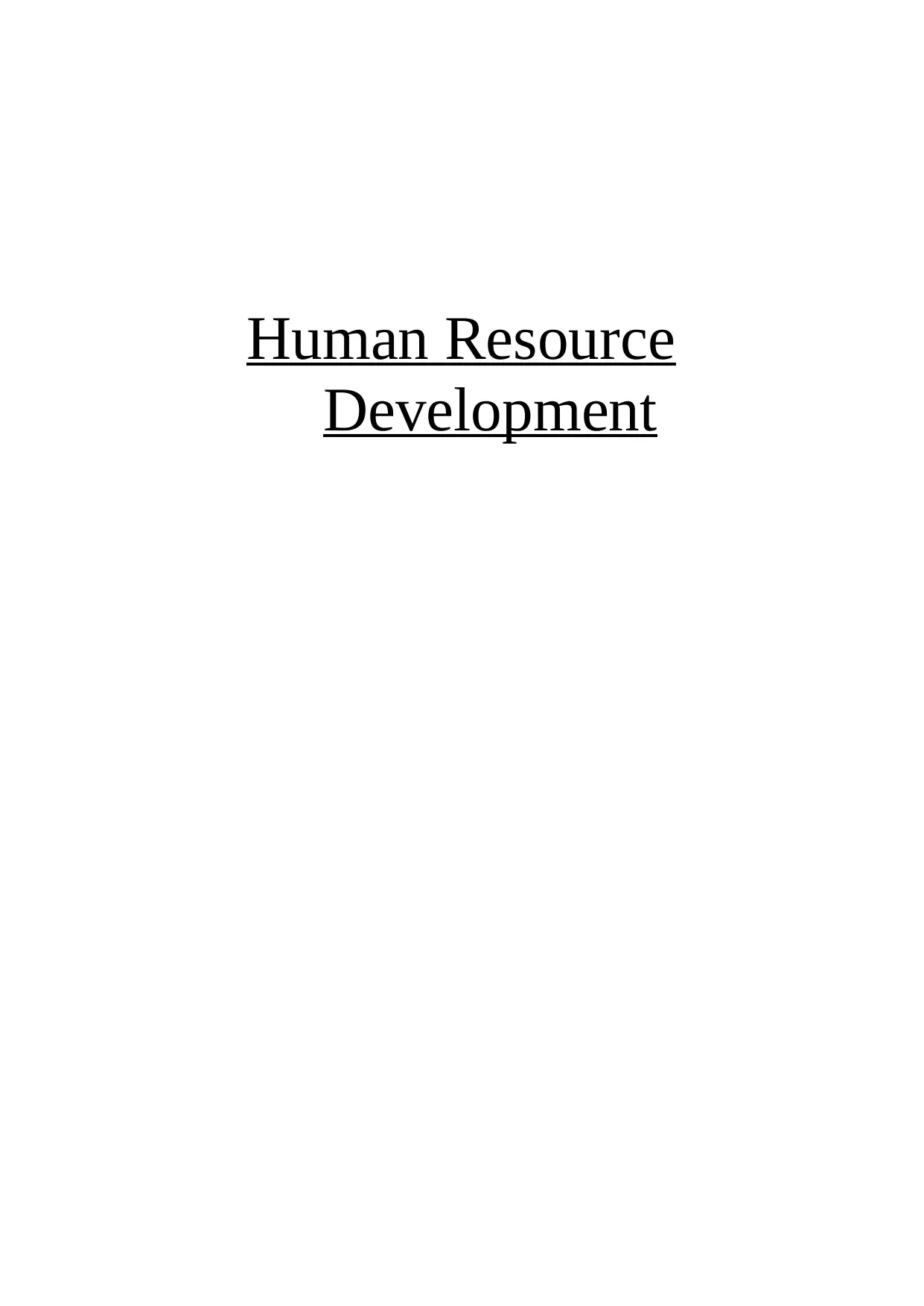
Human Resource
Development
Development
Paraphrase This Document
Need a fresh take? Get an instant paraphrase of this document with our AI Paraphraser
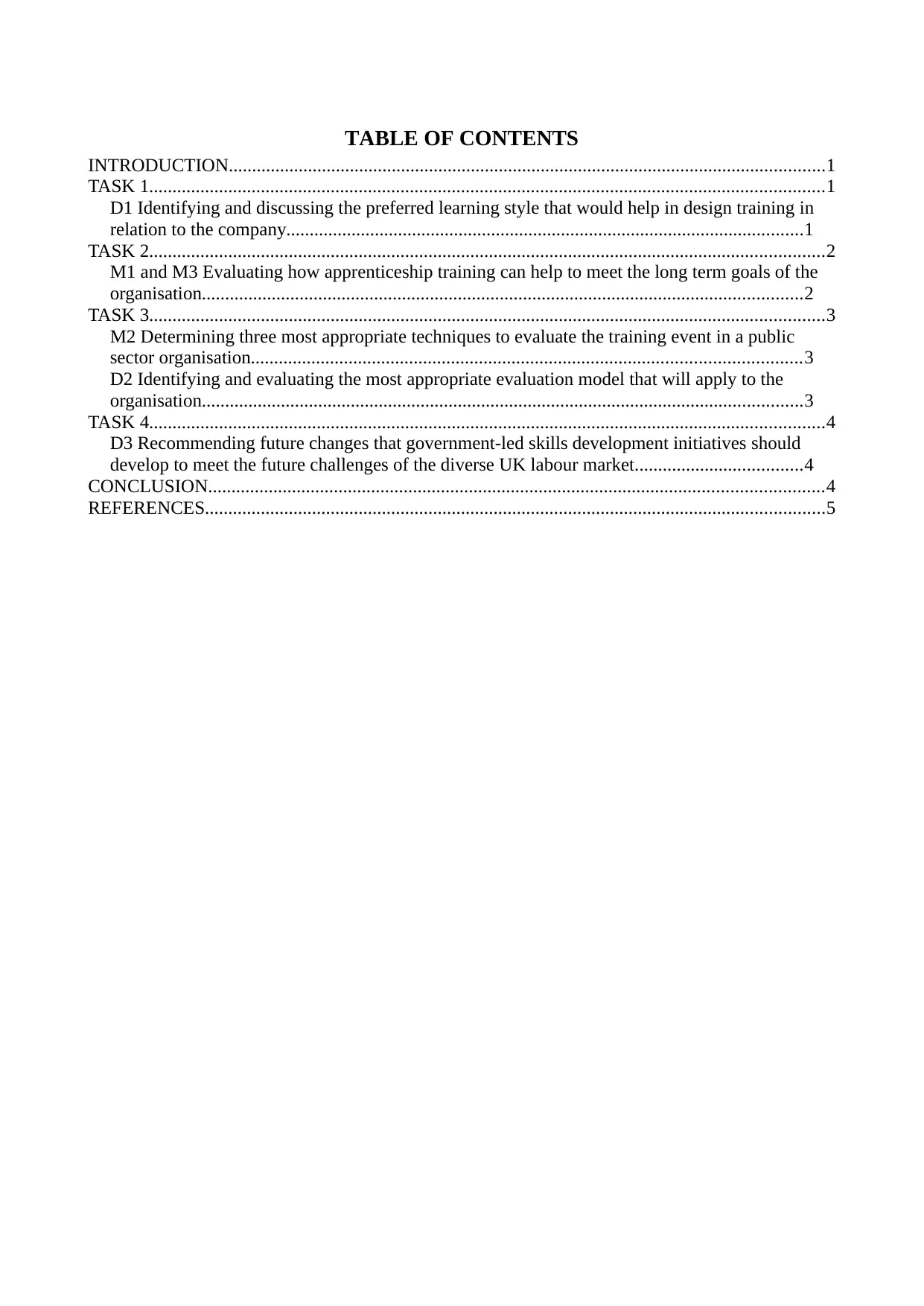
TABLE OF CONTENTS
INTRODUCTION................................................................................................................................1
TASK 1.................................................................................................................................................1
D1 Identifying and discussing the preferred learning style that would help in design training in
relation to the company...............................................................................................................1
TASK 2.................................................................................................................................................2
M1 and M3 Evaluating how apprenticeship training can help to meet the long term goals of the
organisation.................................................................................................................................2
TASK 3.................................................................................................................................................3
M2 Determining three most appropriate techniques to evaluate the training event in a public
sector organisation......................................................................................................................3
D2 Identifying and evaluating the most appropriate evaluation model that will apply to the
organisation.................................................................................................................................3
TASK 4.................................................................................................................................................4
D3 Recommending future changes that government-led skills development initiatives should
develop to meet the future challenges of the diverse UK labour market....................................4
CONCLUSION....................................................................................................................................4
REFERENCES.....................................................................................................................................5
INTRODUCTION................................................................................................................................1
TASK 1.................................................................................................................................................1
D1 Identifying and discussing the preferred learning style that would help in design training in
relation to the company...............................................................................................................1
TASK 2.................................................................................................................................................2
M1 and M3 Evaluating how apprenticeship training can help to meet the long term goals of the
organisation.................................................................................................................................2
TASK 3.................................................................................................................................................3
M2 Determining three most appropriate techniques to evaluate the training event in a public
sector organisation......................................................................................................................3
D2 Identifying and evaluating the most appropriate evaluation model that will apply to the
organisation.................................................................................................................................3
TASK 4.................................................................................................................................................4
D3 Recommending future changes that government-led skills development initiatives should
develop to meet the future challenges of the diverse UK labour market....................................4
CONCLUSION....................................................................................................................................4
REFERENCES.....................................................................................................................................5
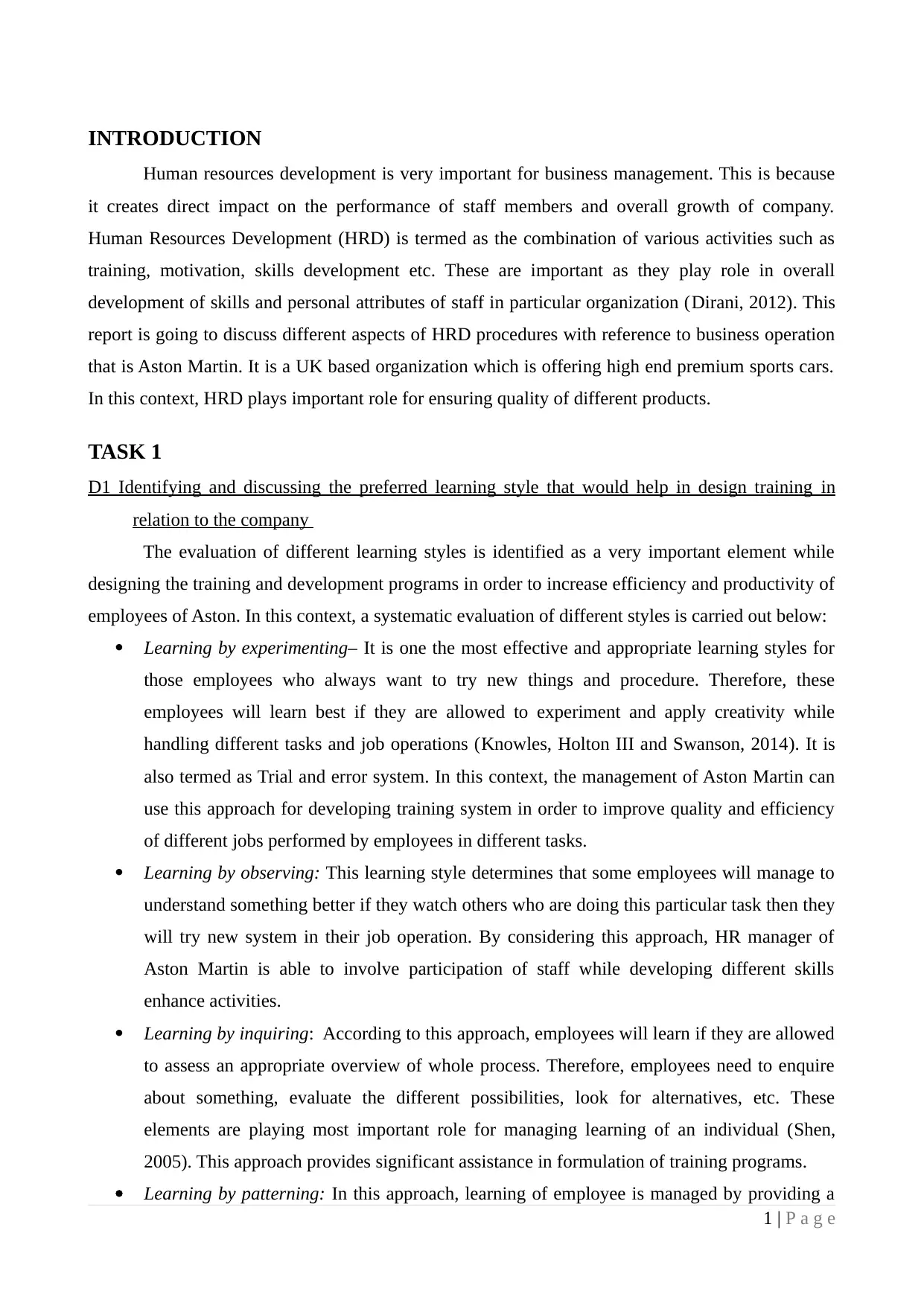
INTRODUCTION
Human resources development is very important for business management. This is because
it creates direct impact on the performance of staff members and overall growth of company.
Human Resources Development (HRD) is termed as the combination of various activities such as
training, motivation, skills development etc. These are important as they play role in overall
development of skills and personal attributes of staff in particular organization (Dirani, 2012). This
report is going to discuss different aspects of HRD procedures with reference to business operation
that is Aston Martin. It is a UK based organization which is offering high end premium sports cars.
In this context, HRD plays important role for ensuring quality of different products.
TASK 1
D1 Identifying and discussing the preferred learning style that would help in design training in
relation to the company
The evaluation of different learning styles is identified as a very important element while
designing the training and development programs in order to increase efficiency and productivity of
employees of Aston. In this context, a systematic evaluation of different styles is carried out below:
Learning by experimenting– It is one the most effective and appropriate learning styles for
those employees who always want to try new things and procedure. Therefore, these
employees will learn best if they are allowed to experiment and apply creativity while
handling different tasks and job operations (Knowles, Holton III and Swanson, 2014). It is
also termed as Trial and error system. In this context, the management of Aston Martin can
use this approach for developing training system in order to improve quality and efficiency
of different jobs performed by employees in different tasks.
Learning by observing: This learning style determines that some employees will manage to
understand something better if they watch others who are doing this particular task then they
will try new system in their job operation. By considering this approach, HR manager of
Aston Martin is able to involve participation of staff while developing different skills
enhance activities.
Learning by inquiring: According to this approach, employees will learn if they are allowed
to assess an appropriate overview of whole process. Therefore, employees need to enquire
about something, evaluate the different possibilities, look for alternatives, etc. These
elements are playing most important role for managing learning of an individual (Shen,
2005). This approach provides significant assistance in formulation of training programs.
Learning by patterning: In this approach, learning of employee is managed by providing a
1 | P a g e
Human resources development is very important for business management. This is because
it creates direct impact on the performance of staff members and overall growth of company.
Human Resources Development (HRD) is termed as the combination of various activities such as
training, motivation, skills development etc. These are important as they play role in overall
development of skills and personal attributes of staff in particular organization (Dirani, 2012). This
report is going to discuss different aspects of HRD procedures with reference to business operation
that is Aston Martin. It is a UK based organization which is offering high end premium sports cars.
In this context, HRD plays important role for ensuring quality of different products.
TASK 1
D1 Identifying and discussing the preferred learning style that would help in design training in
relation to the company
The evaluation of different learning styles is identified as a very important element while
designing the training and development programs in order to increase efficiency and productivity of
employees of Aston. In this context, a systematic evaluation of different styles is carried out below:
Learning by experimenting– It is one the most effective and appropriate learning styles for
those employees who always want to try new things and procedure. Therefore, these
employees will learn best if they are allowed to experiment and apply creativity while
handling different tasks and job operations (Knowles, Holton III and Swanson, 2014). It is
also termed as Trial and error system. In this context, the management of Aston Martin can
use this approach for developing training system in order to improve quality and efficiency
of different jobs performed by employees in different tasks.
Learning by observing: This learning style determines that some employees will manage to
understand something better if they watch others who are doing this particular task then they
will try new system in their job operation. By considering this approach, HR manager of
Aston Martin is able to involve participation of staff while developing different skills
enhance activities.
Learning by inquiring: According to this approach, employees will learn if they are allowed
to assess an appropriate overview of whole process. Therefore, employees need to enquire
about something, evaluate the different possibilities, look for alternatives, etc. These
elements are playing most important role for managing learning of an individual (Shen,
2005). This approach provides significant assistance in formulation of training programs.
Learning by patterning: In this approach, learning of employee is managed by providing a
1 | P a g e
⊘ This is a preview!⊘
Do you want full access?
Subscribe today to unlock all pages.

Trusted by 1+ million students worldwide
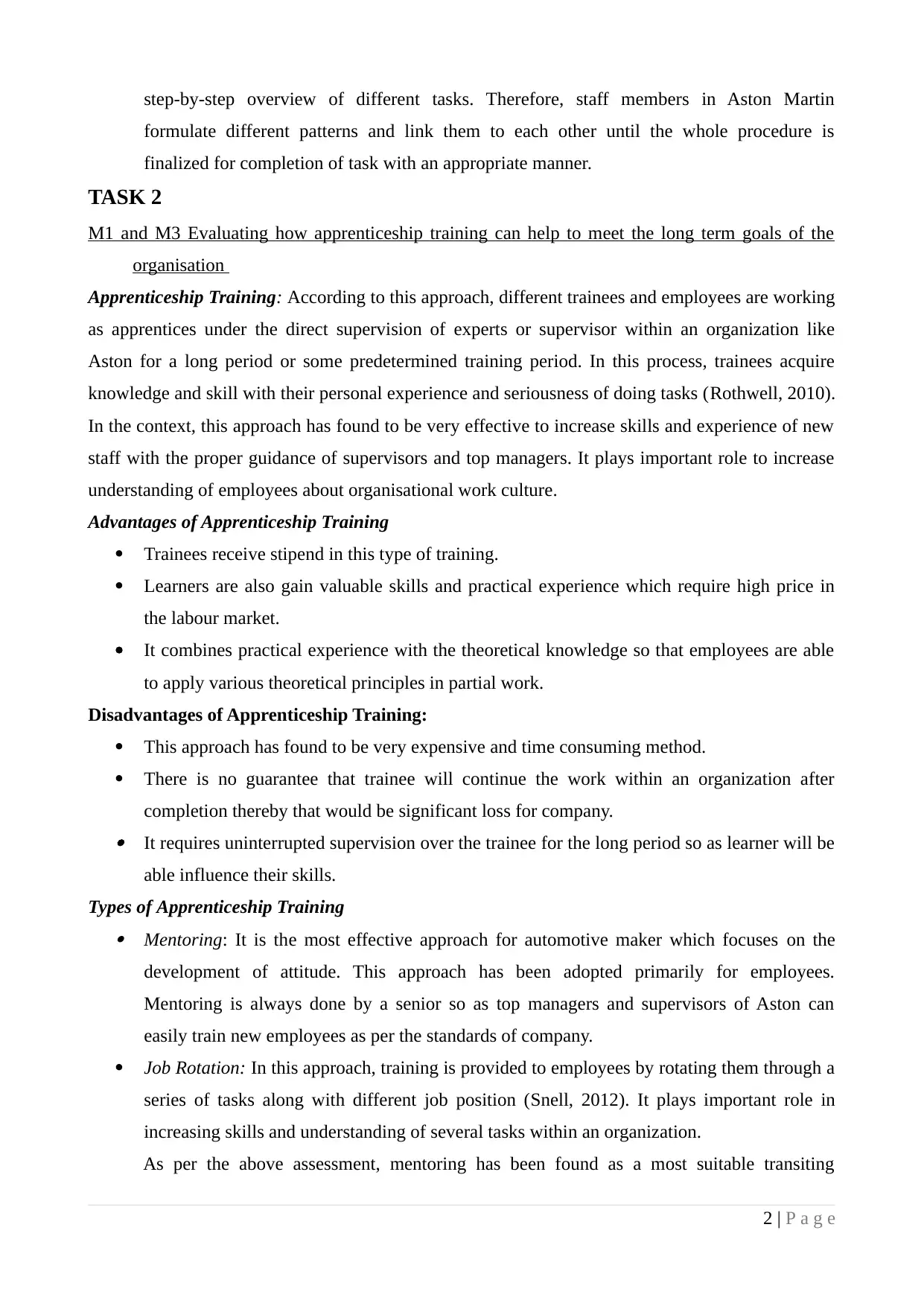
step-by-step overview of different tasks. Therefore, staff members in Aston Martin
formulate different patterns and link them to each other until the whole procedure is
finalized for completion of task with an appropriate manner.
TASK 2
M1 and M3 Evaluating how apprenticeship training can help to meet the long term goals of the
organisation
Apprenticeship Training: According to this approach, different trainees and employees are working
as apprentices under the direct supervision of experts or supervisor within an organization like
Aston for a long period or some predetermined training period. In this process, trainees acquire
knowledge and skill with their personal experience and seriousness of doing tasks (Rothwell, 2010).
In the context, this approach has found to be very effective to increase skills and experience of new
staff with the proper guidance of supervisors and top managers. It plays important role to increase
understanding of employees about organisational work culture.
Advantages of Apprenticeship Training
Trainees receive stipend in this type of training.
Learners are also gain valuable skills and practical experience which require high price in
the labour market.
It combines practical experience with the theoretical knowledge so that employees are able
to apply various theoretical principles in partial work.
Disadvantages of Apprenticeship Training:
This approach has found to be very expensive and time consuming method.
There is no guarantee that trainee will continue the work within an organization after
completion thereby that would be significant loss for company. It requires uninterrupted supervision over the trainee for the long period so as learner will be
able influence their skills.
Types of Apprenticeship Training Mentoring: It is the most effective approach for automotive maker which focuses on the
development of attitude. This approach has been adopted primarily for employees.
Mentoring is always done by a senior so as top managers and supervisors of Aston can
easily train new employees as per the standards of company.
Job Rotation: In this approach, training is provided to employees by rotating them through a
series of tasks along with different job position (Snell, 2012). It plays important role in
increasing skills and understanding of several tasks within an organization.
As per the above assessment, mentoring has been found as a most suitable transiting
2 | P a g e
formulate different patterns and link them to each other until the whole procedure is
finalized for completion of task with an appropriate manner.
TASK 2
M1 and M3 Evaluating how apprenticeship training can help to meet the long term goals of the
organisation
Apprenticeship Training: According to this approach, different trainees and employees are working
as apprentices under the direct supervision of experts or supervisor within an organization like
Aston for a long period or some predetermined training period. In this process, trainees acquire
knowledge and skill with their personal experience and seriousness of doing tasks (Rothwell, 2010).
In the context, this approach has found to be very effective to increase skills and experience of new
staff with the proper guidance of supervisors and top managers. It plays important role to increase
understanding of employees about organisational work culture.
Advantages of Apprenticeship Training
Trainees receive stipend in this type of training.
Learners are also gain valuable skills and practical experience which require high price in
the labour market.
It combines practical experience with the theoretical knowledge so that employees are able
to apply various theoretical principles in partial work.
Disadvantages of Apprenticeship Training:
This approach has found to be very expensive and time consuming method.
There is no guarantee that trainee will continue the work within an organization after
completion thereby that would be significant loss for company. It requires uninterrupted supervision over the trainee for the long period so as learner will be
able influence their skills.
Types of Apprenticeship Training Mentoring: It is the most effective approach for automotive maker which focuses on the
development of attitude. This approach has been adopted primarily for employees.
Mentoring is always done by a senior so as top managers and supervisors of Aston can
easily train new employees as per the standards of company.
Job Rotation: In this approach, training is provided to employees by rotating them through a
series of tasks along with different job position (Snell, 2012). It plays important role in
increasing skills and understanding of several tasks within an organization.
As per the above assessment, mentoring has been found as a most suitable transiting
2 | P a g e
Paraphrase This Document
Need a fresh take? Get an instant paraphrase of this document with our AI Paraphraser
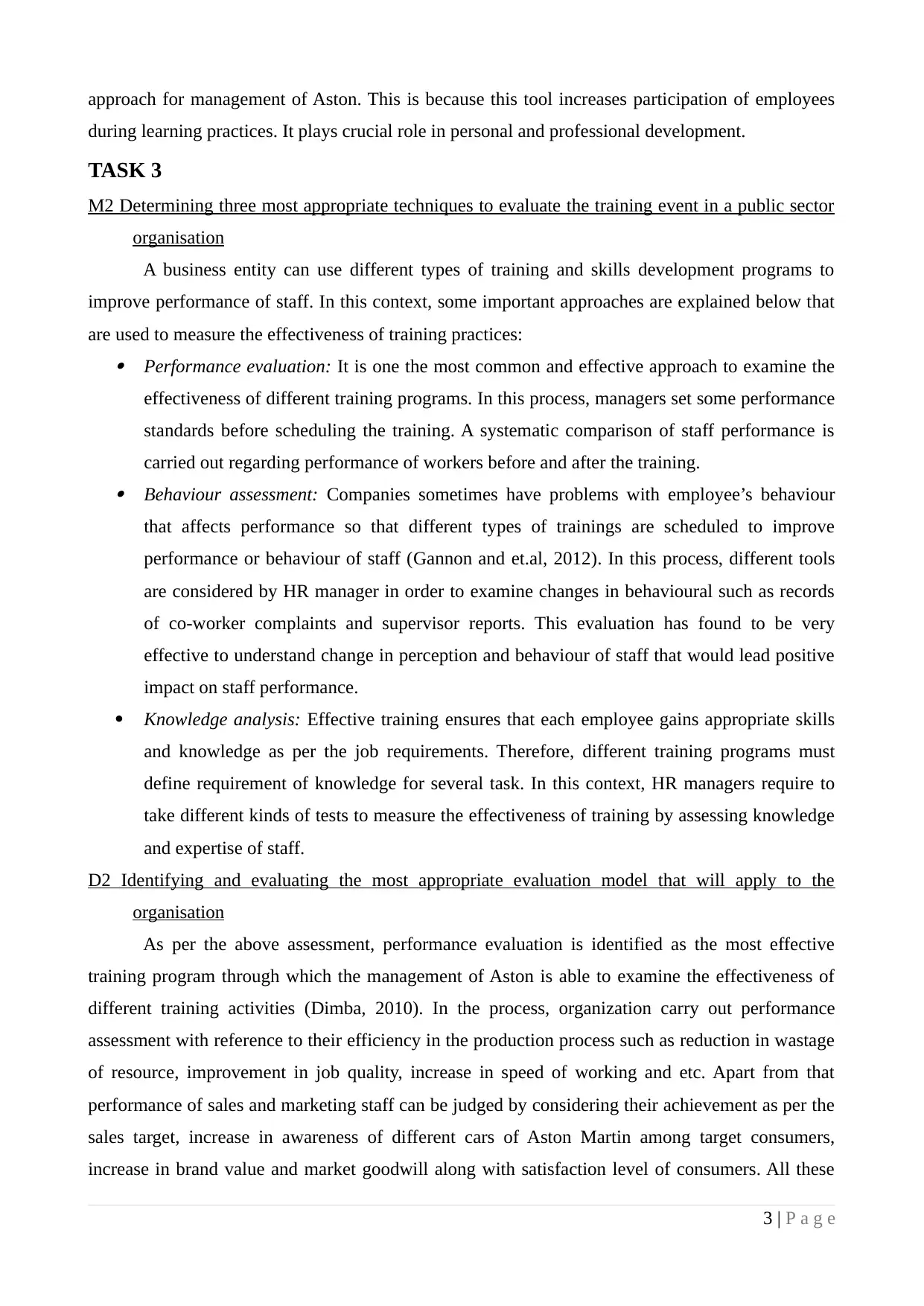
approach for management of Aston. This is because this tool increases participation of employees
during learning practices. It plays crucial role in personal and professional development.
TASK 3
M2 Determining three most appropriate techniques to evaluate the training event in a public sector
organisation
A business entity can use different types of training and skills development programs to
improve performance of staff. In this context, some important approaches are explained below that
are used to measure the effectiveness of training practices: Performance evaluation: It is one the most common and effective approach to examine the
effectiveness of different training programs. In this process, managers set some performance
standards before scheduling the training. A systematic comparison of staff performance is
carried out regarding performance of workers before and after the training. Behaviour assessment: Companies sometimes have problems with employee’s behaviour
that affects performance so that different types of trainings are scheduled to improve
performance or behaviour of staff (Gannon and et.al, 2012). In this process, different tools
are considered by HR manager in order to examine changes in behavioural such as records
of co-worker complaints and supervisor reports. This evaluation has found to be very
effective to understand change in perception and behaviour of staff that would lead positive
impact on staff performance.
Knowledge analysis: Effective training ensures that each employee gains appropriate skills
and knowledge as per the job requirements. Therefore, different training programs must
define requirement of knowledge for several task. In this context, HR managers require to
take different kinds of tests to measure the effectiveness of training by assessing knowledge
and expertise of staff.
D2 Identifying and evaluating the most appropriate evaluation model that will apply to the
organisation
As per the above assessment, performance evaluation is identified as the most effective
training program through which the management of Aston is able to examine the effectiveness of
different training activities (Dimba, 2010). In the process, organization carry out performance
assessment with reference to their efficiency in the production process such as reduction in wastage
of resource, improvement in job quality, increase in speed of working and etc. Apart from that
performance of sales and marketing staff can be judged by considering their achievement as per the
sales target, increase in awareness of different cars of Aston Martin among target consumers,
increase in brand value and market goodwill along with satisfaction level of consumers. All these
3 | P a g e
during learning practices. It plays crucial role in personal and professional development.
TASK 3
M2 Determining three most appropriate techniques to evaluate the training event in a public sector
organisation
A business entity can use different types of training and skills development programs to
improve performance of staff. In this context, some important approaches are explained below that
are used to measure the effectiveness of training practices: Performance evaluation: It is one the most common and effective approach to examine the
effectiveness of different training programs. In this process, managers set some performance
standards before scheduling the training. A systematic comparison of staff performance is
carried out regarding performance of workers before and after the training. Behaviour assessment: Companies sometimes have problems with employee’s behaviour
that affects performance so that different types of trainings are scheduled to improve
performance or behaviour of staff (Gannon and et.al, 2012). In this process, different tools
are considered by HR manager in order to examine changes in behavioural such as records
of co-worker complaints and supervisor reports. This evaluation has found to be very
effective to understand change in perception and behaviour of staff that would lead positive
impact on staff performance.
Knowledge analysis: Effective training ensures that each employee gains appropriate skills
and knowledge as per the job requirements. Therefore, different training programs must
define requirement of knowledge for several task. In this context, HR managers require to
take different kinds of tests to measure the effectiveness of training by assessing knowledge
and expertise of staff.
D2 Identifying and evaluating the most appropriate evaluation model that will apply to the
organisation
As per the above assessment, performance evaluation is identified as the most effective
training program through which the management of Aston is able to examine the effectiveness of
different training activities (Dimba, 2010). In the process, organization carry out performance
assessment with reference to their efficiency in the production process such as reduction in wastage
of resource, improvement in job quality, increase in speed of working and etc. Apart from that
performance of sales and marketing staff can be judged by considering their achievement as per the
sales target, increase in awareness of different cars of Aston Martin among target consumers,
increase in brand value and market goodwill along with satisfaction level of consumers. All these
3 | P a g e
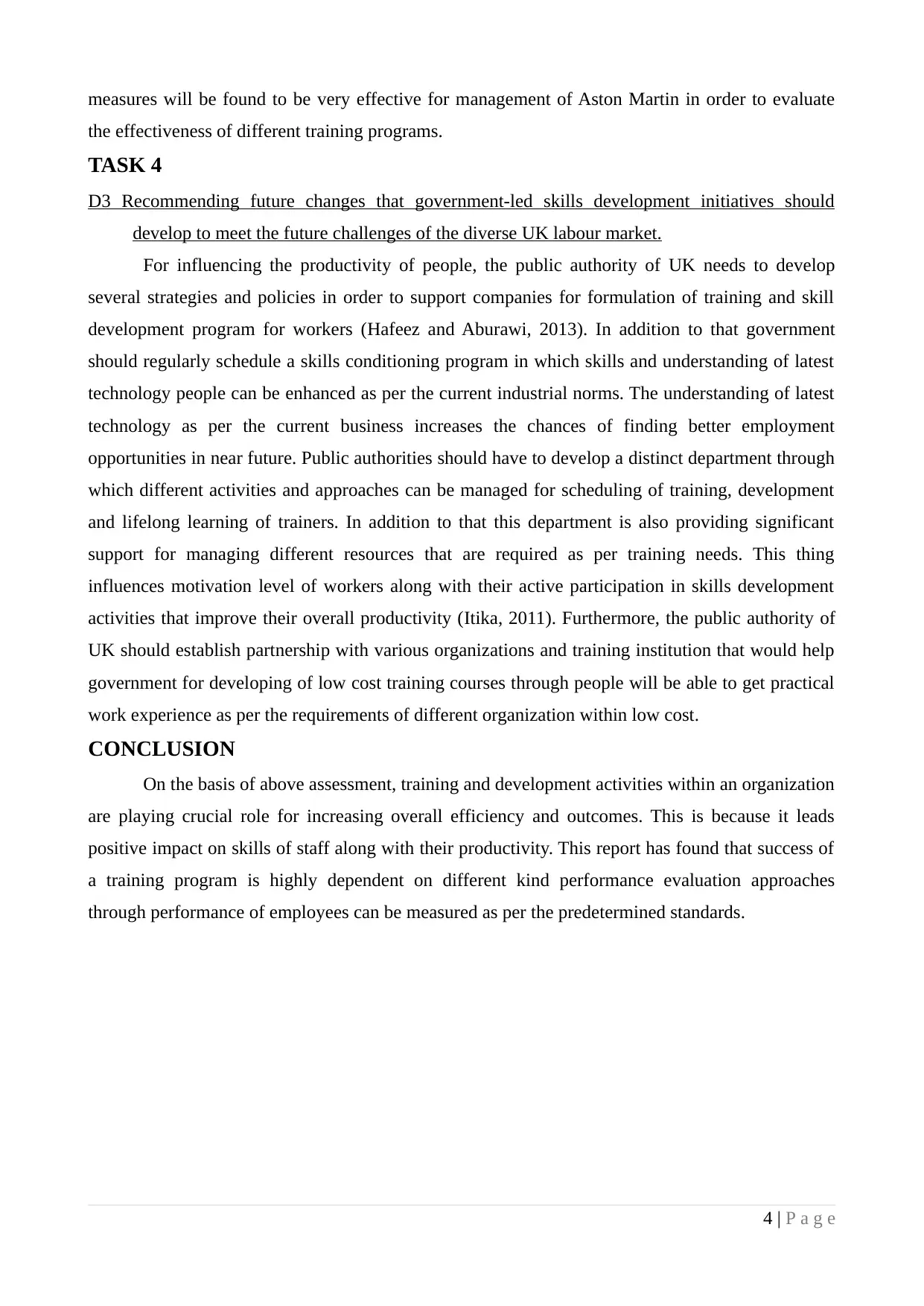
measures will be found to be very effective for management of Aston Martin in order to evaluate
the effectiveness of different training programs.
TASK 4
D3 Recommending future changes that government-led skills development initiatives should
develop to meet the future challenges of the diverse UK labour market.
For influencing the productivity of people, the public authority of UK needs to develop
several strategies and policies in order to support companies for formulation of training and skill
development program for workers (Hafeez and Aburawi, 2013). In addition to that government
should regularly schedule a skills conditioning program in which skills and understanding of latest
technology people can be enhanced as per the current industrial norms. The understanding of latest
technology as per the current business increases the chances of finding better employment
opportunities in near future. Public authorities should have to develop a distinct department through
which different activities and approaches can be managed for scheduling of training, development
and lifelong learning of trainers. In addition to that this department is also providing significant
support for managing different resources that are required as per training needs. This thing
influences motivation level of workers along with their active participation in skills development
activities that improve their overall productivity (Itika, 2011). Furthermore, the public authority of
UK should establish partnership with various organizations and training institution that would help
government for developing of low cost training courses through people will be able to get practical
work experience as per the requirements of different organization within low cost.
CONCLUSION
On the basis of above assessment, training and development activities within an organization
are playing crucial role for increasing overall efficiency and outcomes. This is because it leads
positive impact on skills of staff along with their productivity. This report has found that success of
a training program is highly dependent on different kind performance evaluation approaches
through performance of employees can be measured as per the predetermined standards.
4 | P a g e
the effectiveness of different training programs.
TASK 4
D3 Recommending future changes that government-led skills development initiatives should
develop to meet the future challenges of the diverse UK labour market.
For influencing the productivity of people, the public authority of UK needs to develop
several strategies and policies in order to support companies for formulation of training and skill
development program for workers (Hafeez and Aburawi, 2013). In addition to that government
should regularly schedule a skills conditioning program in which skills and understanding of latest
technology people can be enhanced as per the current industrial norms. The understanding of latest
technology as per the current business increases the chances of finding better employment
opportunities in near future. Public authorities should have to develop a distinct department through
which different activities and approaches can be managed for scheduling of training, development
and lifelong learning of trainers. In addition to that this department is also providing significant
support for managing different resources that are required as per training needs. This thing
influences motivation level of workers along with their active participation in skills development
activities that improve their overall productivity (Itika, 2011). Furthermore, the public authority of
UK should establish partnership with various organizations and training institution that would help
government for developing of low cost training courses through people will be able to get practical
work experience as per the requirements of different organization within low cost.
CONCLUSION
On the basis of above assessment, training and development activities within an organization
are playing crucial role for increasing overall efficiency and outcomes. This is because it leads
positive impact on skills of staff along with their productivity. This report has found that success of
a training program is highly dependent on different kind performance evaluation approaches
through performance of employees can be measured as per the predetermined standards.
4 | P a g e
⊘ This is a preview!⊘
Do you want full access?
Subscribe today to unlock all pages.

Trusted by 1+ million students worldwide
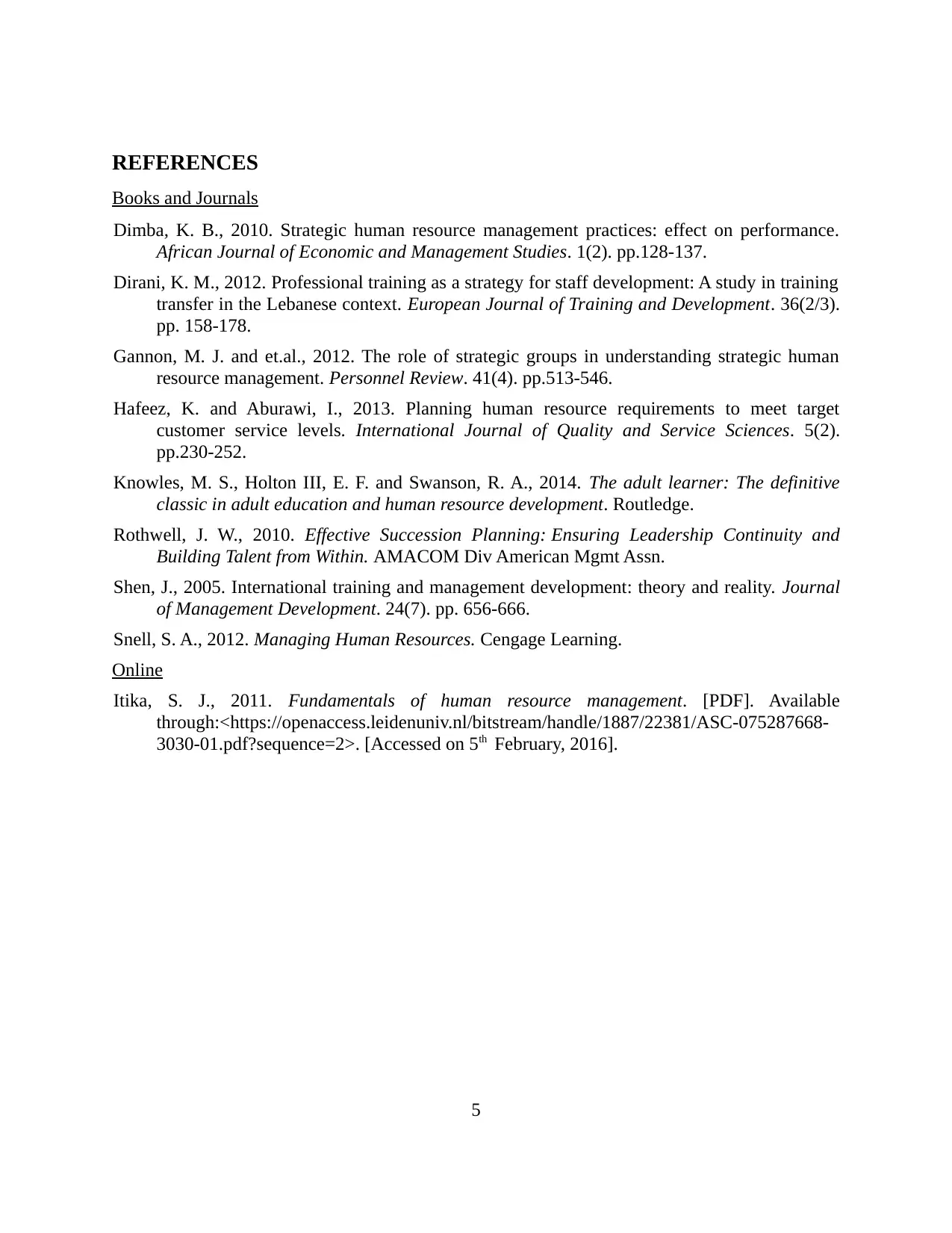
REFERENCES
Books and Journals
Dimba, K. B., 2010. Strategic human resource management practices: effect on performance.
African Journal of Economic and Management Studies. 1(2). pp.128-137.
Dirani, K. M., 2012. Professional training as a strategy for staff development: A study in training
transfer in the Lebanese context. European Journal of Training and Development. 36(2/3).
pp. 158-178.
Gannon, M. J. and et.al., 2012. The role of strategic groups in understanding strategic human
resource management. Personnel Review. 41(4). pp.513-546.
Hafeez, K. and Aburawi, I., 2013. Planning human resource requirements to meet target
customer service levels. International Journal of Quality and Service Sciences. 5(2).
pp.230-252.
Knowles, M. S., Holton III, E. F. and Swanson, R. A., 2014. The adult learner: The definitive
classic in adult education and human resource development. Routledge.
Rothwell, J. W., 2010. Effective Succession Planning: Ensuring Leadership Continuity and
Building Talent from Within. AMACOM Div American Mgmt Assn.
Shen, J., 2005. International training and management development: theory and reality. Journal
of Management Development. 24(7). pp. 656-666.
Snell, S. A., 2012. Managing Human Resources. Cengage Learning.
Online
Itika, S. J., 2011. Fundamentals of human resource management. [PDF]. Available
through:<https://openaccess.leidenuniv.nl/bitstream/handle/1887/22381/ASC-075287668-
3030-01.pdf?sequence=2>. [Accessed on 5th February, 2016].
5
Books and Journals
Dimba, K. B., 2010. Strategic human resource management practices: effect on performance.
African Journal of Economic and Management Studies. 1(2). pp.128-137.
Dirani, K. M., 2012. Professional training as a strategy for staff development: A study in training
transfer in the Lebanese context. European Journal of Training and Development. 36(2/3).
pp. 158-178.
Gannon, M. J. and et.al., 2012. The role of strategic groups in understanding strategic human
resource management. Personnel Review. 41(4). pp.513-546.
Hafeez, K. and Aburawi, I., 2013. Planning human resource requirements to meet target
customer service levels. International Journal of Quality and Service Sciences. 5(2).
pp.230-252.
Knowles, M. S., Holton III, E. F. and Swanson, R. A., 2014. The adult learner: The definitive
classic in adult education and human resource development. Routledge.
Rothwell, J. W., 2010. Effective Succession Planning: Ensuring Leadership Continuity and
Building Talent from Within. AMACOM Div American Mgmt Assn.
Shen, J., 2005. International training and management development: theory and reality. Journal
of Management Development. 24(7). pp. 656-666.
Snell, S. A., 2012. Managing Human Resources. Cengage Learning.
Online
Itika, S. J., 2011. Fundamentals of human resource management. [PDF]. Available
through:<https://openaccess.leidenuniv.nl/bitstream/handle/1887/22381/ASC-075287668-
3030-01.pdf?sequence=2>. [Accessed on 5th February, 2016].
5
1 out of 7
Related Documents
Your All-in-One AI-Powered Toolkit for Academic Success.
+13062052269
info@desklib.com
Available 24*7 on WhatsApp / Email
![[object Object]](/_next/static/media/star-bottom.7253800d.svg)
Unlock your academic potential
Copyright © 2020–2025 A2Z Services. All Rights Reserved. Developed and managed by ZUCOL.





